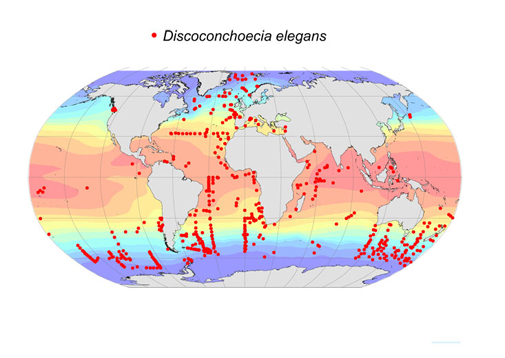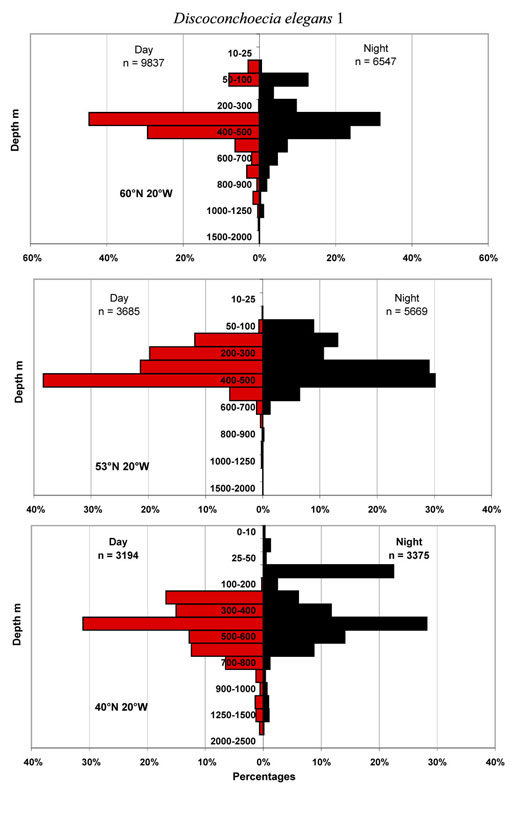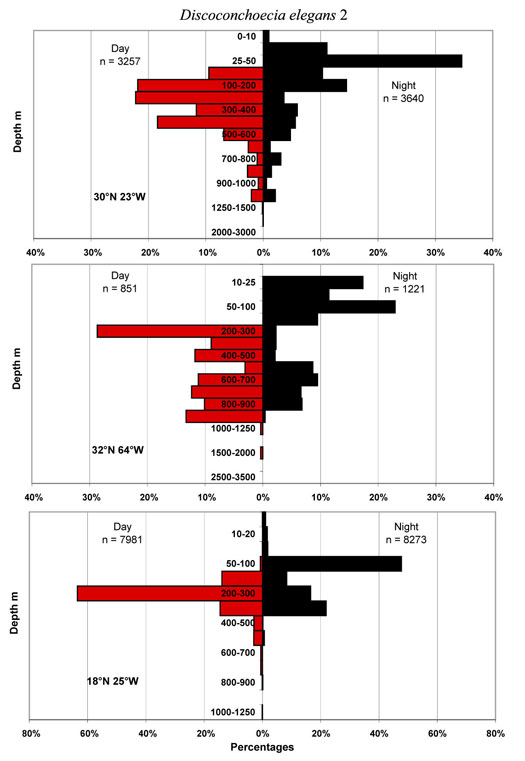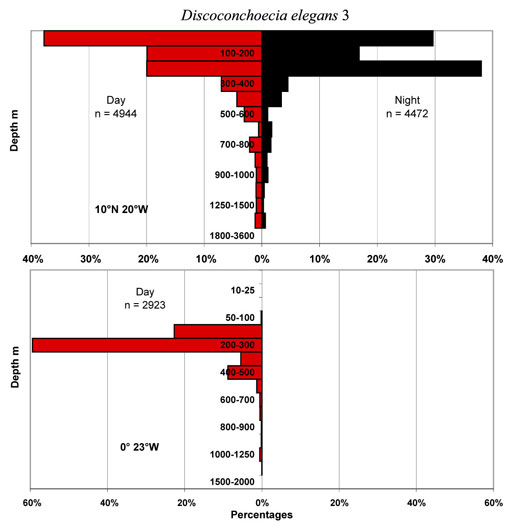Notes
1343 records
This was one of the first halocyprids to be described by Sars from samples collected off the Lofoten Islands off northwestern Norway. Since then it has been the most frequently recorded of all halocyprid species. Müller (1906) classified it in his ‘elegans’ group of species, which he defined as those species with an oval pad of hairs as the armature on the e seta of the male first antenna, noting its similarity to D. discophora. Müller (1906) also stated that the species not only has an unusually wide range of carapace lengths (♀ - 1.1-2.1 mm; ♂ - 1.0-2.0mm) but also that the lengths decrease with decreasing latitude. Skogsberg (1920) gave a detailed description of specimens from the Southern Ocean and Deevey (1968) illustrated a small form collected off Bermuda. Poulsen (1973) placed the species in Claus’s genus Paraconchoecia and described a new closely related species P. tamensis from a single male specimen (1.1mm) sampled off Indonesia. Martens (1979) placed these species in a new genus Discoconchoecia. Attributing an adult male specimen to this genus is straightforward, but as the size data given below indicates, it is unlikely that all the specimens attributed to elegans are the same species. In the Atlantic typically sized specimens occur at high latitudes and in the cold water outflows from the Arctic in the Labrador Sea. At tropical and subtropical latitudes the adult carapace lengths are almost half the typical length, and the size distributions of adults and juvenile instars are well defined and the length/size distributions are disjunct. However, at temperate latitudes (see 44°N data) the length/size distributions are continuous so that it is impossible to separate the juvenile instars and even the adult females on the basis of carapace length. Angel (1977) likened this distribution of sizes to a hybrid swarm. Specimens caught at deeper depths to be larger, but this trend is too vague to suggest there is any sort of bathymetric segregation. This problem of identity of this abundant and often dominant mesopelagic species may only be resolved by a molecular genetics study.
| Svalblad ~80°N
|
N
|
Mean mm
|
s.d.
|
Range mm
|
|---|
| Female
|
20
|
2.01
|
0.082
|
1.92-2.22
|
|---|
| Male
|
11
|
2.19
|
0.087
|
2.08-2.36
|
|---|
| A-1
|
13
|
1.77
|
0.034
|
1.72-1.84
|
|---|
| A-2
|
8
|
1.51
|
0.073
|
1.42-1.60
|
|---|
| A-3
|
9
|
1.23
|
0.065
|
1.14-1.32
|
|---|
| A-4
|
12
|
1.00
|
0.043
|
0.94-1.06
|
|---|
| A-5
|
13
|
0.65
|
0.031
|
0.60-0.70
|
|---|
| Labrador Sea
|
N
|
Mean mm
|
s.d.
|
Range mm
|
|---|
| Female
|
72
|
1.90
|
0.066
|
1.76-2.04
|
|---|
| Male
| 13
|
2.03
|
0.088
|
1.96-2.04 (2.16)
|
|---|
| A-1
|
40
|
1.62
|
0.042
|
1.54-1.72
|
|---|
| A-2
|
31
|
1.36
|
0.048
|
1.30-1.50
|
|---|
| A-3
|
72
|
0.98
|
0.078
|
0.82-1.12
|
|---|
| A-4
|
71
|
0.64
|
0.027
|
0.58-0.74
|
|---|
| A-5
|
22
|
0.43
|
0.019
|
0.40-0.44
|
|---|
| Raunefjord, Norway
|
n
|
Mean mm
|
s.d.
|
Range mm
|
|---|
| Female
|
14
|
2.07
|
0.111
|
1.86-2.35
|
|---|
| Male
|
|
|
|
|
|---|
| A-1
|
21
|
1.54
|
0.126
|
1.35-1.74
|
|---|
| A-2
|
40
|
1.02
|
0.064
|
0.86-1.14
|
|---|
| A-3
|
115
|
0.67
|
0.032
|
0.63-0.74
|
|---|
| A-4
|
248
|
0.44
|
0.021
|
0.42-0.51
|
|---|
| A-5
|
186
|
0.31
|
0.020
|
0.28-0.35
|
|---|
| 60°N 20°W
|
n
|
Mean mm
|
s.d.
|
Range mm
|
|---|
| Female
|
222
|
1.70
|
0.076
|
1.58-1.98
|
|---|
| Female
|
215
|
1.86
|
0.057
|
1.68-1.98
|
|---|
| A-1
|
218
|
1.49
|
0.052
|
1.34-1.56
|
|---|
| A-2
|
211
|
1.23
|
0.056
|
1.06-1.30
|
|---|
| A-3
|
263
|
0.97
|
0.052
|
0.88-1.04
|
|---|
| A-4
|
143
|
0.83
|
0.039
|
0.64-0.86
|
|---|
| 53°N 20°W
|
n
|
Mean mm
|
s.d.
|
Range mm
|
|---|
| Female
| 215
|
1.69
|
0.058
|
1.58-1.84
|
|---|
| Male
|
209
|
1.81
|
0.052
|
1.58-1.94
|
|---|
| A-1
|
241
|
1.48
|
0.044
|
1.34-1.56
|
|---|
| A-2
|
203
|
1.19
|
0.047
|
1.06-1.30
|
|---|
| A-3
|
137
|
0.95
|
0.038
|
0.88-1.04
|
|---|
| A-4
|
95
|
0.82
|
0.038
|
0.74-0.86
|
|---|
| A-5
|
3
|
|
|
0.68-0.70
|
|---|
| 44°N 13°W
|
n
|
Mean mm
|
s.d.
|
Range mm
|
|---|
| Females + juvs
|
3267
|
|
|
0.70-1.66
|
|---|
| Male
|
334
|
1.45
|
0.108
|
1.14-1.98
|
|---|
| Canary Is.
|
n
|
Mean mm
|
s.d.
|
Range mm
|
|---|
| Female
|
272
|
1.24
|
0.045
|
1.18-1.40
|
|---|
| Male
|
58
|
1.17
|
0.032
|
1.10-1.25
|
|---|
| A-1
|
210
|
1.06
|
0.042
|
1.00-1.15
|
|---|
| A-2
|
31
|
0.94
|
0.025
|
0.88-0.98
|
|---|
| A-3
|
1
|
|
|
0.75
|
|---|
| 30°N 23°W
|
n
|
Mean mm
|
s.d.
|
Range mm
|
|---|
| Female
|
275
|
1.25
|
0.036
|
1.16-1.36
|
|---|
| Male
|
175
|
1.23
|
0.053
|
1.12-1.34
|
|---|
| A-1
|
222
|
1.06
|
0.032
|
1.00-1.14
|
|---|
| A-2
|
148
|
0.93
|
0.028
|
0.86-0.98
|
|---|
| A-3
|
3
|
|
|
0.74-0.76
|
|---|
| 11° 20°W
|
n
|
Mean mm
|
s.d.
|
Range mm
|
|---|
| Female
|
226
|
1.27
|
0.038
|
0.88-1.08
|
|---|
| Male
| 215
|
1.19
|
0.320
|
1.10-1.26
|
|---|
| A-1
|
223
|
0.99
|
0.046
|
0.88-1.08
|
|---|
| Equator
|
n
|
Mean mm
|
s.d.
|
Range mm
|
|---|
| Female
|
2080
|
1.23
|
0.052
|
1.10-1.38
|
|---|
| Male
|
545
|
1.24
|
0.057
|
1.02-1.38
|
|---|
| A-1
|
310
|
1.03
|
0.029
|
0.98-1.08
|
|---|
| A-2
|
440
|
0.90
|
0.049
|
0.70-0.96
|
|---|
| Benguela (Small)
|
n
|
Mean mm
|
s.d.
|
Range mm
|
|---|
| Female
|
150
|
1.36
|
0.055
|
1.20-1.46
|
|---|
| Male
|
86
|
1.27
|
0.034
|
1.20-1.34
|
|---|
| A-1
|
185
|
1.04
|
0.057
|
0.86-1.14
|
|---|
| A-2
|
59
|
0.74
|
0.038
|
0.64-0.82
|
|---|
| Benguela (Large)
|
n
|
Mean mm
|
s.d.
|
Range mm
|
|---|
| Female
|
15
|
1.59
|
0.046
|
1.50-1.66
|
|---|
| Male
| 26
|
1.60
|
0.049
|
1.46-1.68
|
|---|
| A-1
|
|
|
|
|
|---|
| A-2
|
|
|
|
|
|---|
| Southern Ocean
|
n
|
Mean mm
|
s.d.
|
Range mm
|
|---|
| Female
| 187
|
1.64
|
0.060
|
1.52-1.84
|
|---|
| Male
|
92
|
1.76
|
0.070
|
1.50-1.88
|
|---|
| A-1
|
174
|
1.45
|
0.019
|
1.36-1.56
|
|---|
| A-2
|
113
|
1.20
|
0.045
|
1.10-1.32
|
|---|
| A-3
|
71
|
0.94
|
0.064
|
0.74-1.02
|
|---|
| A-4
|
2
|
0.61
|
|
0.60-0.62
|
|---|







